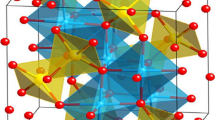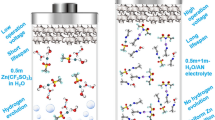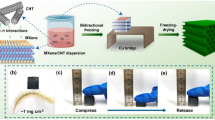Abstract
Transition metal sulfides such as MoS2 and VS2 have emerged as promising candidates for energy storage applications in recent years. Among the reported transition metal sulfides, the patronite (VS4) form of vanadium sulfide is less explored and understanding its charge storage mechanisms is unusual in the literature. Here, we report the pseudocapacitive energy storage performance of patronite (VS4) nano-bundles synthesized via template-free hydrothermal approach by fabricating a solid-state asymmetric supercapacitor device (SSAD) with MXene (Ti3C2Tx) as the negative electrode. The fabricated VS4//MXene SSAD displayed a remarkable supercapacitive behavior in an expanded working potential window of 1.3 V. The device demonstrated a record high performance with the areal capacitance of 70.9 mF/cm2 at the scan rate of 5 mV/s and demonstrated ~ 4.5 and ~ 6 times superior areal capacitance as compared to the bare VS4 nano-bundles and MXene-based symmetric devices. Further, the device displayed an excellent energy density of 5.65 mW h/cm2 with a remarkable power density of 290.9 mW/cm2 and good cyclic stability ~ 75% after 3000 cycles in neutral electrolyte. Moreover, we have performed extensive density functional theory simulations to present electronic properties of VS4 and MXene supporting pseudocapacitive behavior for VS4 through reversible Faradic redox reactions and pre-dominant electrical double-layer capacitive behavior for MXene due to intercalation/de-intercalation of ions. The diffusion energy barrier for electrolytic ions is lower in VS4 (only 0.17 eV) satisfying better and rapid transport of charge carriers generated in VS4 justifying high charge storage performance. Populated electronic states for V 3d orbital in both the valence band and conduction band justify superior redox-type behavior for VS4 supporting experimental observations.
Graphical abstract

Enhanced energy storage performance of asymmetric supercapacitors based on VS4 and MXene.








Similar content being viewed by others
References
Bauer S, Bauer-Gogonea S, Graz I et al (2014) 25th anniversary article: a soft future: from robots and sensor skin to energy harvesters. Adv Mater 26:149–162. https://doi.org/10.1002/adma.201303349
Son D, Lee J, Qiao S et al (2014) Multifunctional wearable devices for diagnosis and therapy of movement disorders. Nat Nanotechnol 9:397–404. https://doi.org/10.1038/nnano.2014.38
Huang Y, Zhu M, Pei Z et al (2016) A shape memory supercapacitor and its application in smart energy storage textiles. J Mater Chem A 4:1290–1297. https://doi.org/10.1039/C5TA09473A
Dubal DP, Chodankar NR, Kim D-H, Gomez-Romero P (2018) Towards flexible solid-state supercapacitors for smart and wearable electronics. Chem Soc Rev 47:2065–2129. https://doi.org/10.1039/C7CS00505A
Lu Y, Jiang K, Chen D, Shen G (2019) Wearable sweat monitoring system with integrated micro-supercapacitors. Nano Energy 58:624–632. https://doi.org/10.1016/j.nanoen.2019.01.084
Ning F, He X, Shen Y et al (2017) Flexible and lightweight fuel cell with high specific power density. ACS Nano 11:5982–5991. https://doi.org/10.1021/acsnano.7b01880
Hu Y, Sun X (2014) Flexible rechargeable lithium ion batteries: advances and challenges in materials and process technologies. J Mater Chem A 2:10712–10738. https://doi.org/10.1039/C4TA00716F
Palchoudhury S, Ramasamy K, Gupta RK, Gupta A (2019) Flexible supercapacitors: a materials perspective. Front Mater. https://doi.org/10.3389/fmats.2018.00083
Wang G, Zhang L, Zhang J (2012) A review of electrode materials for electrochemical supercapacitors. Chem Soc Rev 41:797–828. https://doi.org/10.1039/C1CS15060J
Peng X, Peng L, Wu C, Xie Y (2014) Two dimensional nanomaterials for flexible supercapacitors. Chem Soc Rev 43:3303–3323. https://doi.org/10.1039/C3CS60407A
Samal R, Chakraborty B, Saxena M et al (2019) Facile production of mesoporous WO3-rGO hybrids for high-performance supercapacitor electrodes: an experimental and computational study. ACS Sustain Chem Eng 7:2350–2359. https://doi.org/10.1021/acssuschemeng.8b05132
Ratha S, Rout CS (2013) Supercapacitor electrodes based on layered tungsten disulfide-reduced graphene oxide hybrids synthesized by a facile hydrothermal method. ACS Appl Mater Interfaces 5:11427–11433. https://doi.org/10.1021/am403663f
Kurra N, Xia C, Hedhili NM, Alshareef NH (2015) Ternary chalcogenide micro-pseudocapacitors for on-chip energy storage. Chem Commun 51:10494–10497. https://doi.org/10.1039/C5CC03220B
Cao L, Yang S, Gao W et al (2013) Direct laser-patterned micro-supercapacitors from paintable MoS2 films. Small 9:2905–2910. https://doi.org/10.1002/smll.201203164
Feng J, Sun X, Wu C et al (2011) Metallic few-layered VS2 ultrathin nanosheets: high two-dimensional conductivity for in-plane supercapacitors. J Am Chem Soc 133:17832–17838. https://doi.org/10.1021/ja207176c
Liu B-T, Shi X-M, Lang X-Y et al (2018) Extraordinary pseudocapacitive energy storage triggered by phase transformation in hierarchical vanadium oxides. Nat Commun 9:1375. https://doi.org/10.1038/s41467-018-03700-3
Liu L, Zhao H, Lei Y (2019) Review on nanoarchitectured current collectors for pseudocapacitors. Small Methods 3:1800341. https://doi.org/10.1002/smtd.201800341
Choi C, Ashby DS, Butts DM et al (2020) Achieving high energy density and high power density with pseudocapacitive materials. Nat Rev Mater 5:5–19. https://doi.org/10.1038/s41578-019-0142-z
An C, Zhang Y, Guo H, Wang Y (2019) Metal oxide-based supercapacitors: progress and prospectives. Nanoscale Adv 1:4644–4658. https://doi.org/10.1039/C9NA00543A
Li X, Du D, Zhang Y et al (2017) Layered double hydroxides toward high-performance supercapacitors. J Mater Chem A 5:15460–15485. https://doi.org/10.1039/C7TA04001F
Yuan S, Pang S-Y, Hao J (2020) 2D transition metal dichalcogenides, carbides, nitrides, and their applications in supercapacitors and electrocatalytic hydrogen evolution reaction. Appl Phys Rev 7:021304. https://doi.org/10.1063/5.0005141
Pandit B, Bommineedi LK, Sankapal BR (2019) Electrochemical engineering approach of high performance solid-state flexible supercapacitor device based on chemically synthesized VS2 nanoregime structure. J Energy Chem 31:79–88. https://doi.org/10.1016/j.jechem.2018.05.011
Wang X, Zhang Y, Zheng J et al (2020) Fabrication of vanadium sulfide (VS4) wrapped with carbonaceous materials as an enhanced electrode for symmetric supercapacitors. J Colloid Interface Sci 574:312–323. https://doi.org/10.1016/j.jcis.2020.04.072
Naguib M, Kurtoglu M, Presser V et al (2011) Two-dimensional nanocrystals produced by exfoliation of Ti3AlC2. Adv Mater 23:4248–4253. https://doi.org/10.1002/adma.201102306
Zhang C, Anasori B, Seral-Ascaso A et al (2017) Transparent, flexible, and conductive 2D titanium carbide (MXene) films with high volumetric capacitance. Adv Mater 29:1702678. https://doi.org/10.1002/adma.201702678
Qian A, Pang Y, Wang G et al (2020) Pseudocapacitive charge storage in MXene–V2O5 for asymmetric flexible energy storage devices. ACS Appl Mater Interfaces 12:54791–54797. https://doi.org/10.1021/acsami.0c16959
Couly C, Alhabeb M, Aken KLV et al (2018) Asymmetric flexible mxene-reduced graphene oxide micro-supercapacitor. Adv Electron Mater 4:1700339. https://doi.org/10.1002/aelm.201700339
Li K, Wang X, Wang X et al (2020) All-pseudocapacitive asymmetric MXene-carbon-conducting polymer supercapacitors. Nano Energy 75:104971. https://doi.org/10.1016/j.nanoen.2020.104971
Jiang Q, Kurra N, Alhabeb M et al (2018) All pseudocapacitive MXene-RuO2 asymmetric supercapacitors. Adv Energy Mater 8:1703043. https://doi.org/10.1002/aenm.201703043
Jing Y, Zhou Z, Cabrera CR, Chen Z (2013) Metallic VS2 monolayer: a promising 2D anode material for lithium ion batteries. J Phys Chem C 117:25409–25413. https://doi.org/10.1021/jp410969u
Lui G, Jiang G, Duan A et al (2015) Synthesis and characterization of template-free VS4 nanostructured materials with potential application in photocatalysis. Ind Eng Chem Res 54:2682–2689. https://doi.org/10.1021/ie5042287
Rout CS, Kim B-H, Xu X et al (2013) Synthesis and characterization of patronite form of vanadium sulfide on graphitic layer. J Am Chem Soc 135:8720–8725. https://doi.org/10.1021/ja403232d
Sun R, Wei Q, Sheng J et al (2017) Novel layer-by-layer stacked VS2 nanosheets with intercalation pseudocapacitance for high-rate sodium ion charge storage. Nano Energy 35:396–404. https://doi.org/10.1016/j.nanoen.2017.03.036
Xu X, Jeong S, Rout CS et al (2014) Lithium reaction mechanism and high rate capability of VS4–graphene nanocomposite as an anode material for lithium batteries. J Mater Chem A 2:10847–10853. https://doi.org/10.1039/C4TA00371C
Kozlova MN, Mironov YV, Grayfer ED et al (2015) Synthesis, crystal structure, and colloidal dispersions of vanadium tetrasulfide (VS4). Chem: A Eur J 21:4639–4645. https://doi.org/10.1002/chem.201406428
Zhou Y, Li Y, Yang J et al (2016) Conductive polymer-coated VS4 submicrospheres as advanced electrode materials in lithium-ion batteries. ACS Appl Mater Interfaces 8:18797–18805. https://doi.org/10.1021/acsami.6b04444
Yang G, Zhang B, Feng J et al (2018) High-crystallinity urchin-like VS4 anode for high-performance lithium-ion storage. ACS Appl Mater Interfaces 10:14727–14734. https://doi.org/10.1021/acsami.8b01876
Kresse G, Hafner J (1993) Ab initio molecular dynamics for liquid metals. Phys Rev B 47:558–561. https://doi.org/10.1103/PhysRevB.47.558
Kresse G, Hafner J (1994) Ab initio molecular-dynamics simulation of the liquid-metal–amorphous-semiconductor transition in germanium. Phys Rev B 49:14251–14269. https://doi.org/10.1103/PhysRevB.49.14251
Kresse G, Joubert D (1999) From ultrasoft pseudopotentials to the projector augmented-wave method. Phys Rev B 59:1758–1775. https://doi.org/10.1103/PhysRevB.59.1758
Perdew JP, Burke K, Ernzerhof M (1996) Generalized gradient approximation made simple. Phys Rev Lett 77:3865–3868. https://doi.org/10.1103/PhysRevLett.77.3865
Grimme S, Antony J, Ehrlich S, Krieg H (2010) A consistent and accurate ab initio parametrization of density functional dispersion correction (DFT-D) for the 94 elements H-Pu. J Chem Phys 132:154104. https://doi.org/10.1063/1.3382344
Wang Y, Liu Z, Wang C et al (2018) Highly branched VS4 nanodendrites with 1D atomic-chain structure as a promising cathode material for long-cycling magnesium batteries. Adv Mater 30:1802563. https://doi.org/10.1002/adma.201802563
Costentin C, Porter TR, Savéant J-M (2017) How do pseudocapacitors store energy? Theoretical analysis and experimental illustration. ACS Appl Mater Interfaces 9:8649–8658. https://doi.org/10.1021/acsami.6b14100
Ratha S, Marri SR, Lanzillo NA et al (2015) Supercapacitors based on patronite–reduced graphene oxide hybrids: experimental and theoretical insights. J Mater Chem A 3:18874–18881. https://doi.org/10.1039/C5TA03221K
Simon P, Gogotsi Y, Dunn B (2014) Where do batteries end and supercapacitors begin? Science 343:1210–1211. https://doi.org/10.1126/science.1249625
Moosavifard SE, Shamsi J, Altafi MK, Moosavifard ZS (2016) All-solid state, flexible, high-energy integrated hybrid micro-supercapacitors based on 3D LSG/CoNi2S4 nanosheets. Chem Commun 52:13140–13143. https://doi.org/10.1039/C6CC07053A
Zhang P, Wang L, Wang F et al (2019) A nonaqueous Na-ion hybrid micro-supercapacitor with wide potential window and ultrahigh areal energy density. Batteries Supercaps 2:918–923. https://doi.org/10.1002/batt.201900079
Li J-C, Gong J, Zhang X et al (2020) Alternate integration of vertically oriented CuSe@FeOOH and CuSe@MnOOH hybrid nanosheets frameworks for flexible in-plane asymmetric micro-supercapacitors. ACS Appl Energy Mater 3:3692–3703. https://doi.org/10.1021/acsaem.0c00150
Xie Y, Zhang H, Huang H et al (2020) High-voltage asymmetric MXene-based on-chip micro-supercapacitors. Nano Energy 74:104928. https://doi.org/10.1016/j.nanoen.2020.104928
Jiang Q, Kurra N, Xia C, Alshareef HN (2017) Hybrid microsupercapacitors with vertically scaled 3D current collectors fabricated using a simple cut-and-transfer strategy. Adv Energy Mater 7:1601257. https://doi.org/10.1002/aenm.201601257
Soram BS, Dai JY, Thangjam IS et al (2020) One-step electrodeposited MoS2@Ni-mesh electrode for flexible and transparent asymmetric solid-state supercapacitors. J Mater Chem A 8:24040–24052. https://doi.org/10.1039/D0TA07764J
Chen Q, Jin J, Kou Z et al (2020) Cobalt-doping in hierarchical Ni3S2 nanorod arrays enables high areal capacitance. J Mater Chem A 8:13114–13120. https://doi.org/10.1039/D0TA04483K
Shao Y, Fu J-H, Cao Z et al (2020) 3D crumpled ultrathin 1T MoS2 for inkjet printing of Mg-Ion asymmetric micro-supercapacitors. ACS Nano 14:7308–7318. https://doi.org/10.1021/acsnano.0c02585
Ali BA, Metwalli OI, Khalil ASG, Allam NK (2018) Unveiling the effect of the structure of carbon material on the charge storage mechanism in MoS2-based supercapacitors. ACS Omega 3:16301–16308. https://doi.org/10.1021/acsomega.8b02261
Sarkar D, Das D, Das S et al (2019) Expanding interlayer spacing in MoS2 for realizing an advanced supercapacitor. ACS Energy Lett 4:1602–1609. https://doi.org/10.1021/acsenergylett.9b00983
Lukatskaya MR, Mashtalir O, Ren CE et al (2013) Cation intercalation and high volumetric capacitance of two-dimensional titanium carbide. Science 341:1502–1505. https://doi.org/10.1126/science.1241488
Zhan C, Naguib M, Lukatskaya M et al (2018) Understanding the MXene pseudocapacitance. J Phys Chem Lett 9:1223–1228. https://doi.org/10.1021/acs.jpclett.8b00200
Naguib M, Adams RA, Zhao Y et al (2017) Electrochemical performance of MXenes as K-ion battery anodes. Chem Commun 53:6883–6886. https://doi.org/10.1039/C7CC02026K
Sonia YK, Paliwal MK, Meher SK (2021) The rational design of hierarchical CoS2/CuCo2S4 for three-dimensional all-solid-state hybrid supercapacitors with high energy density, rate efficiency, and operational stability. Sustain Energy Fuels 5:973–985. https://doi.org/10.1039/D0SE01698E
Xing L, Owusu KA, Liu X et al (2021) Insights into the storage mechanism of VS4 nanowire clusters in aluminum-ion battery. Nano Energy 79:105384. https://doi.org/10.1016/j.nanoen.2020.105384
Heyd J, Scuseria GE, Ernzerhof M (2003) Hybrid functionals based on a screened coulomb potential. J Chem Phys 118:8207–8215. https://doi.org/10.1063/1.1564060
Li S, He J, Nachtigall P et al (2021) Doping isolated one-dimensional antiferromagnetic semiconductor vanadium tetrasulfide (VS4) nanowires with carriers induces half-metallicity. J Mater Chem C 9:3122–3128. https://doi.org/10.1039/D1TC00096A
Kozlova MN, Enyashin AN, Fedorov VE (2016) Quantum-chemical study of quasi-one-dimensional vanadium and niobium sulfides with Peierls distortion. J Struct Chem 57:1505–1512. https://doi.org/10.1134/S0022476616080035
Ran J, Gao G, Li F-T et al (2017) Ti 3 C 2 MXene co-catalyst on metal sulfide photo-absorbers for enhanced visible-light photocatalytic hydrogen production. Nat Commun 8:13907. https://doi.org/10.1038/ncomms13907
Yang GM, Zhang HZ, Fan XF, Zheng WT (2015) Density functional theory calculations for the quantum capacitance performance of graphene-based electrode material. J Phys Chem C 119:6464–6470. https://doi.org/10.1021/jp512176r
Pathak M, Jose JR, Chakraborty B, Rout CS (2020) High performance supercapacitor electrodes based on spinel NiCo2O4@MWCNT composite with insights from density functional theory simulations. J Chem Phys 152:064706. https://doi.org/10.1063/1.5138727
A SRK, Shajahan SA, Chakraborty B, Rout CS (2020) The role of carbon nanotubes in enhanced charge storage performance of VSe 2: experimental and theoretical insight from DFT simulations. RSC Advances 10:31712–31719. https://doi.org/10.1039/D0RA06773C
Acknowledgements
The authors would like to acknowledge the financial support by the Department of Science and Technology (DST)-SERB Early Career Research project (Grant No. ECR/2017/001850), DST-Nanomission (DST/NM/NT/2019/205(G), DST/TDT/SHRI-34/2018) and Karnataka Science and Technology Promotion Society (KSTePS/VGST-RGS-F/2018-19/GRD NO. 829/315). BC thanks Dr. Nandini Garg, Dr. T. Sakuntala, Dr. S.M. Yusuf and Dr. A K Mohanty for their support and encouragement. We also acknowledge the BARC Computer Centre supercomputing facility and thank their staff for continuous help and support.
Author information
Authors and Affiliations
Corresponding authors
Ethics declarations
Conflict of interest
The authors declare no conflict of interest.
Additional information
Handling Editor: Kevin Jones.
Publisher's Note
Springer Nature remains neutral with regard to jurisdictional claims in published maps and institutional affiliations.
Supplementary Information
Below is the link to the electronic supplementary material.
Rights and permissions
About this article
Cite this article
Sharma, A., Patra, A., Namsheer, K. et al. All-solid-state asymmetric supercapacitors based on VS4 nano-bundles and MXene nanosheets. J Mater Sci 56, 20008–20025 (2021). https://doi.org/10.1007/s10853-021-06537-2
Received:
Accepted:
Published:
Issue Date:
DOI: https://doi.org/10.1007/s10853-021-06537-2




